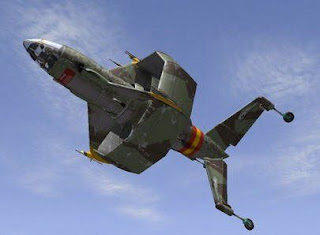 |
| Heinkel "Lark" (Picture I) |
Kimmo Huosionmaa
Heinkel "Lark" ("Lerche") (or Wasp "Wespe") was one of the Nazi-Germany's last plans to change the route of the War against allied nations, and this is the official truth about this plane. But in fact there is a question, about this plane, that is this plan made actually some American team and was the purpose of this VTOL-plane only be that it should give the reason for recruiting Nazi-scientists after World War II because the western allies didn't want that those scientists would go in hands of the Soviet Union. The structure of those aircraft would be very interesting, and if there would be the pike in the nose and the rim around it would be used as the generator, would that thing make this aircraft the electromagnetic weapon, what would use the pike to target that weapon, what might use radio- or microwaves to terminate the target.
But there are many strange details of that thing. Do you know, that "Lark" actually could fly in space, if it would use magneto dynamic driving propulsion? In this scenario, the rim, what would surround the body of this aircraft would be equipped with the magnetic accelerator, what would suck ions thru it. There are actually three ways to give electric power to that system. One is used power-cells or turbo generators, what would use oxygenated fuel.
Second is to use the nuclear reactor and the last one could be pumping the external radio waves or other electromagnetic radiation to that vehicle, what might use that electricity as the wireless electric transmitter. Or if the planner of that vehicle would want, this person might install the normal rocket to that vehicle, and when the propel would rise this plane very high altitude, the rocket would rise it out of the atmosphere, but the electromagnetic drive would give more possibilities than the normal rocket. And in that metal rim would, in fact, conduct so sturdy magnets, that the WARP-drive could be possible if the power system uses a nuclear reactor for creating the electricity. That would raise the voltage so high, that the WARP-drive would be possible. The system would not necessarily drive the spacecraft faster than light, but it can open the gates to all solar system.
But when we are thinking about the flying with propels, we might think that the propels would take the aircraft to the extremely high altitude, and then the rocket motor or electromagnetic drive would be started, and that motor would raise the aircraft to the orbital trajectory. The shape of the "Lark" has given the innovation to some very small size drones, what are actually the flying antitank weapons. In this case, the portable antitank missile like "Dragon", would be put in the tube, where is installed the opposite rotating propels, what is seen in the drawings of "Lark".
This system can be very devastating against helicopters and tanks. It can be dropped from the aircraft or some other platforms like helicopters. The idea of that thing, what might be called as the "Mini Lark" is some sci-fi action movies, and I don't know who has made those things. But they are the very interesting way to see the capacity of the military drones. Those weapons can fly to the battlefield and operate against tanks and other vehicles.
Sources:
https://hubpages.com/education/Hitlers-Heinkel-Lerche-The-First-VTOL-Aircraft
https://en.wikipedia.org/wiki/Warp_drive
Picture I
https://i.pinimg.com/originals/3d/ba/51/3dba515a8f9db10fe8d78bd1cd7d1585.jpg




No comments:
Post a Comment
Note: Only a member of this blog may post a comment.